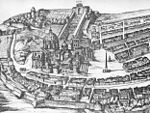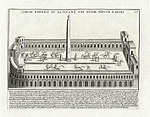Paul VI Audience Hall
The Paul VI Audience Hall (Italian: Aula Paolo VI) also known as the Hall of the Pontifical Audiences is a building in Rome named for Pope Paul VI with a seating capacity of 6,300, designed in reinforced concrete by the Italian architect Pier Luigi Nervi and completed in 1971. It was constructed on land donated by the Knights of Columbus.It lies partially in the Vatican City but mostly in Italy: the Italian part of the building is treated as an extraterritorial area of the Holy See, and is used by the Pope as an alternative to Saint Peter's Square when conducting his Wednesday morning General Audience. It is dominated by an 800-quintal (80-tonne) bronze/copper-alloy sculpture by Pericle Fazzini entitled La Resurrezione (Italian for The Resurrection). A smaller meeting hall, known as Synod Hall (Aula del Sinodo), is located in the building as well. This hall sits at the east end on a second floor.
Excerpt from the Wikipedia article Paul VI Audience Hall (License: CC BY-SA 3.0, Authors).Paul VI Audience Hall
Via di Porta Cavalleggeri, Rome Aurelio
Geographical coordinates (GPS) Address External links Nearby Places Show on map
Geographical coordinates (GPS)
| Latitude | Longitude |
|---|---|
| N 41.900694444444 ° | E 12.454694444444 ° |
Address
Exedra ex Pontificalibus Audientiis Pauli VI
Via di Porta Cavalleggeri
00193 Rome, Aurelio
Lazio, Italy
Open on Google Maps









